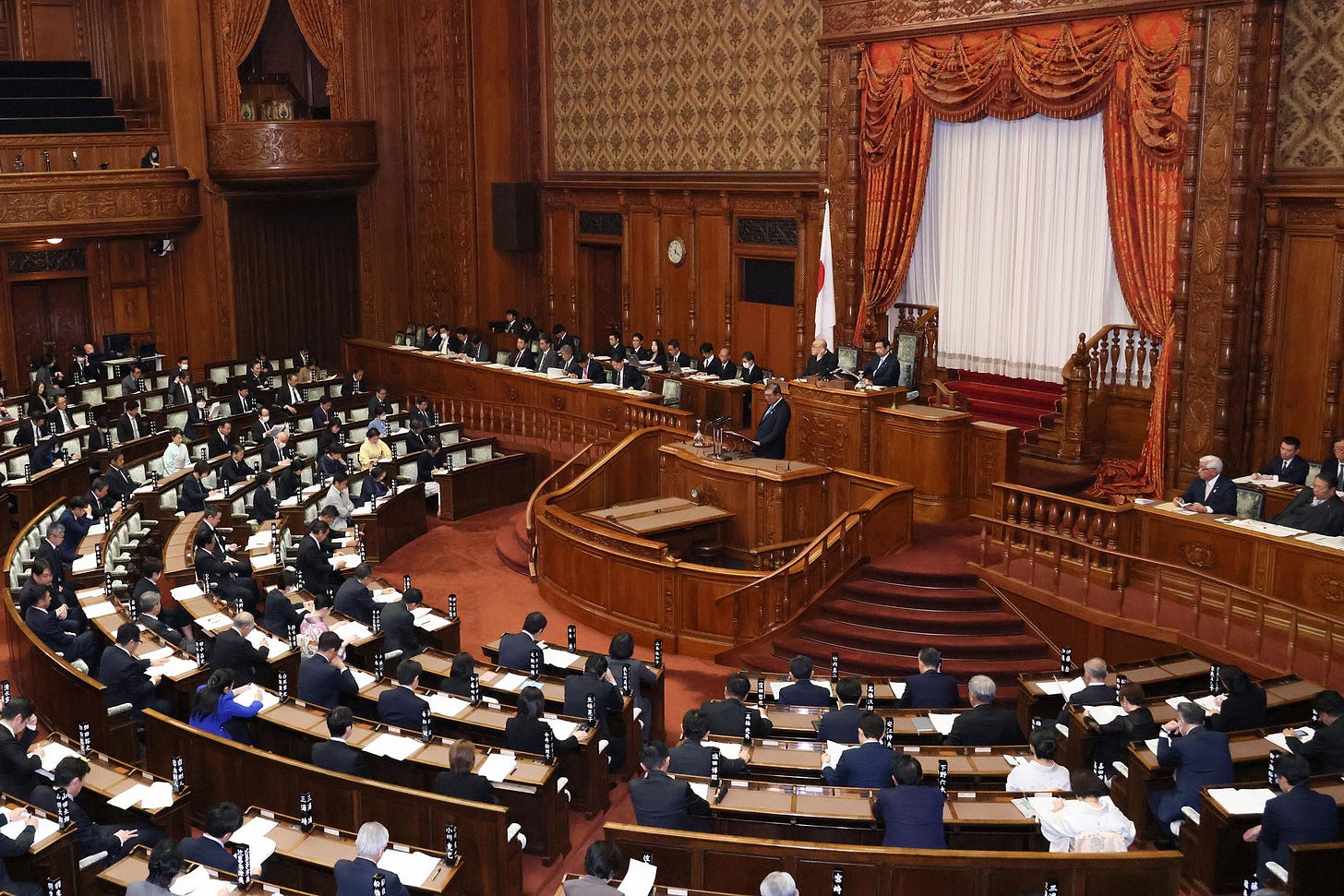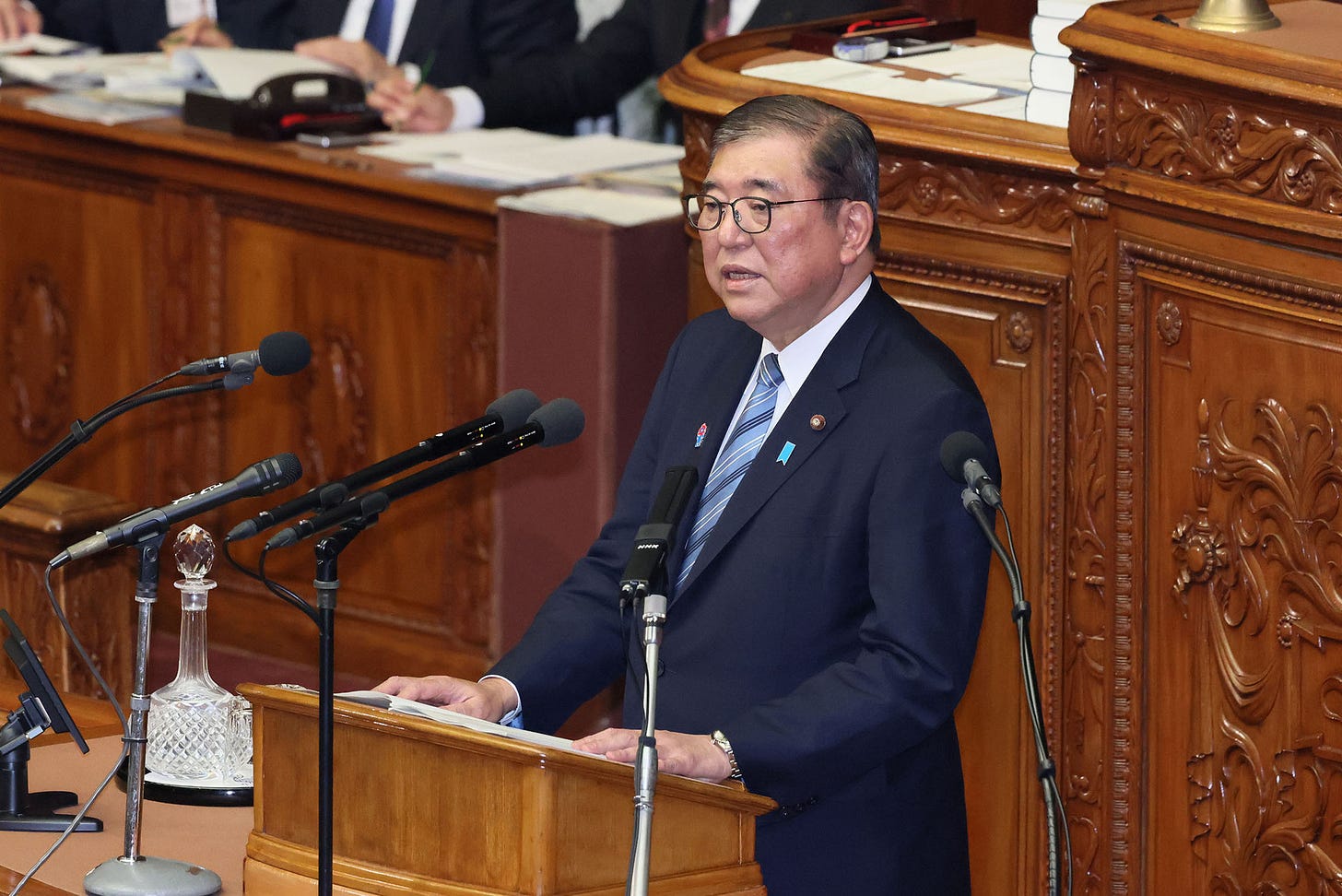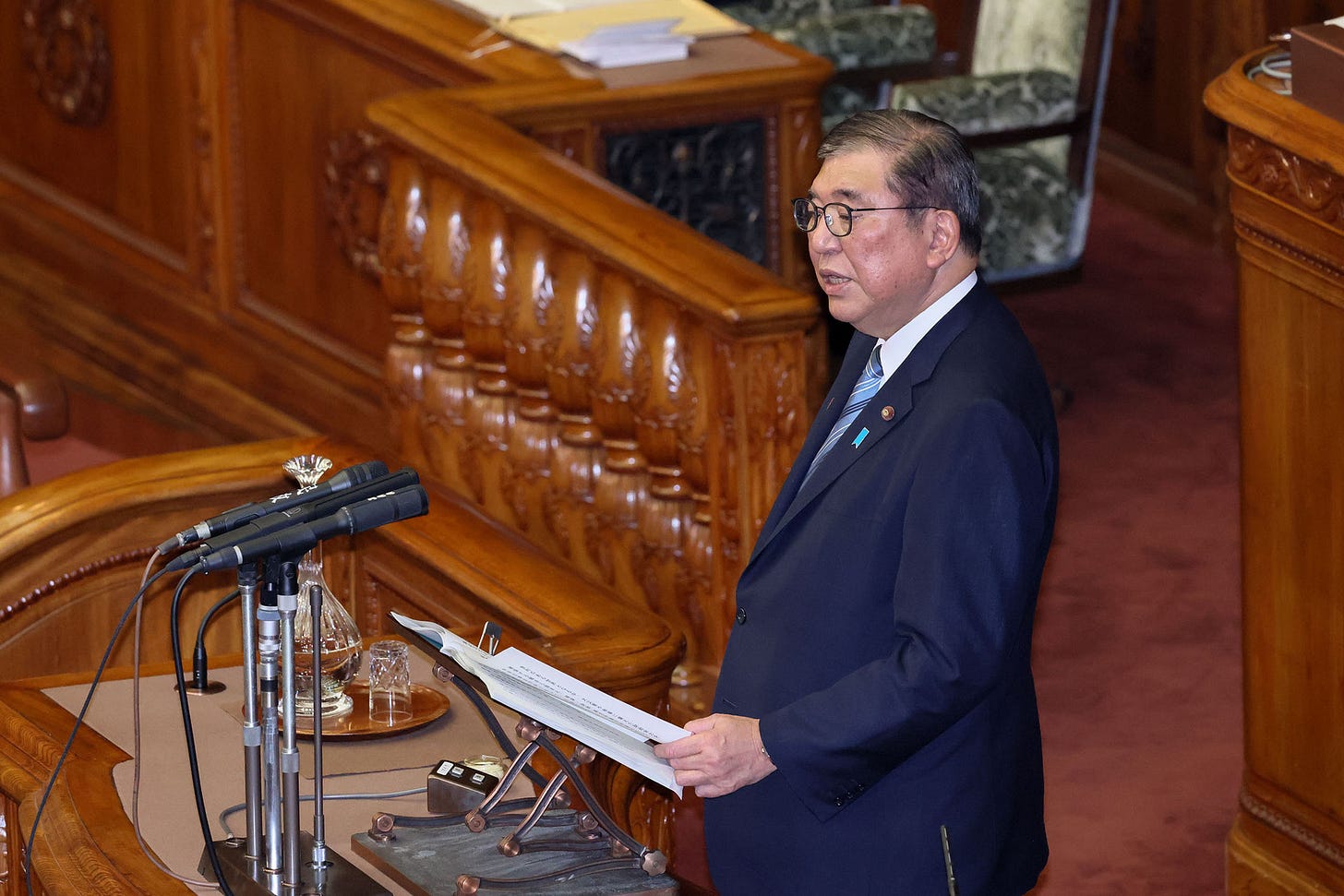Thank you for reading Observing Japan. This post is available to all readers.
If you are looking for timely, forward-looking analysis of the stories in Japan’s politics and policymaking that move markets, I have launched a new service through my business, Japan Foresight LLC. For more information about Japan Foresight’s services or for information on how to sign up for a trial or schedule a briefing, please visit our website or reach out to me.

The ordinary session of the Diet opened on Friday, 24 January with Prime Minister Ishiba Shigeru delivering a policy speech outlining not just his priorities for the new Diet session, which is scheduled to run through 22 June, but a broader policy vision. Noting that 2025 marks both the eightieth anniversary of the end of World War II and the hundredth anniversary of the accession of Emperor Hirohito to the throne, he suggested that Japan once again finds itself grappling with new challenges that will require fundamental changes in how the country is governed.
His overarching term for the Japan he seeks to build is a “pleasant Japan” (楽しい日本), which, borrowing a schema from writer-bureaucrat Sakaiya Taichi, he characterizes as a third stage of development following the state-led “strong Japan” following the Meiji Restoration and the business-led “wealthy Japan” following 1945. At first glance, this concept seems slight, perhaps referring to an approach that centers pop culture and tourism, a Japan that embraces a new status as a destination for recreation.
However, this tagline masks what is actually a sobering account of the tasks facing Japan. As he says in the opening, “In building a new Japan, we must emphasize being sustainable and independent. Therefore, I believe that a change of values is essential.”1 The persistent decline of the working-age population, he says, means that Japanese society needs to become more respectful of each individual and their abilities and needs; Japan’s dependence on foreign sources of food and energy render it vulnerable to overseas events require “strategic national management” to protect the well-being of the Japanese people. While Ishiba makes clear what he means by pleasant – namely a society that respects the diversity and pluralism, enabling individuals to pursue their dreams and “self-actualization” – in practice what he outlines in this speech is less a “pleasant Japan” than a “resilient Japan.”
A new balance of power

Consider what he says about foreign policy. Ishiba’s determination to chart a more independent foreign policy – as discussed here and here – despite the challenges of what he calls, following his predecessor’s language, “the most severe and complex security environment of the postwar era” is immediately apparent. In contrast to his predecessors, whose policy speeches highlighted the US-Japan relationship and other partnerships first before talking about Japan’s own defense capabilities, Ishiba flips the order.
“Defense capabilities are the ultimate guarantee of Japan’s security,” he says. “We will steadily continue to dramatically bolster our defense capabilities, based on the National Security Strategy and other documents, with the fundamental goal of deterring an invasion of Japan by possessing the capabilities needed to prevent or repel an invasion of Japan on our own.” This is a fundamentally different way of talking about Japan’s national defense, even compared with former prime minister Kishida Fumio, under whose leadership Japan launched its current defense buildup.2
He does not argue that Japan, in strengthening its capabilities, should prepare to fight alone. He echoes his predecessors in referring to the US-Japan relationship as the “foundation of Japan’s foreign and security policies.” But the language he uses to describe the importance of US-Japan cooperation is curious. He characterizes it more in negative terms – avoiding a bad outcome – than in positive terms.
“As the balance of power in the region undergoes a historic shift,” he says, “we must ensure the continuing commitment of the United States to the region and further deepen US-Japan cooperation in concrete ways so that power vacuums do not lead to regional instability.”
Ensuring that the United States remains committed to the region has long been the fundamental principle of Japanese foreign policy – I have used this language to describe Abe’s foreign policy, for example – but it is unusual to see a prime minister describe this goal as openly as Ishiba does here.3 To be sure, he eventually refers to the goal of maintaining a “free and open Indo-Pacific,” with the US and Japan playing “an indispensable leadership role” as part of a “multilayered network” of relationships among regional powers. This is, however, a less expansive vision than the global partnership Kishida described when he delivered an address to the US Congress in April 2024. Ishiba gestures towards his pending (though still unscheduled) summit with Trump as an opportunity to discuss this vision and “raise the US-Japan alliance to a higher level.”
Meanwhile, he is candid about the importance of “realistic diplomacy” with China. To be sure, this language is more formulaic – indeed, it is virtually identical to what Kishida said about China policy in 2024 – referencing the phrases reaffirmed in bilateral documents including a “mutually beneficial relationship based on common strategic interests” and “constructive and stable relationship.” But what is notable here is not what Ishiba said, but what he did not say. Whereas Kishida said that Japan would “say what needed to be said” and urge China to behave responsibly and refrain from using force to change the status quo in the East and South China Seas, Ishiba retained Kishida’s “say what needs to be said” phrase but omitted specific references to China’s behavior, saying instead that “China’s stable development is in the interest of the entire region.” In other words, he softens the critical rhetoric about China’s behavior used by both Suga Yoshihide’s and Kishida’s rhetoric during their tenures as prime minister.
This, in short, is the double hedge strategy at work. Ishiba is transparent about the importance of the US-Japan alliance for Japan’s security and regional stability but pares back some of the more effusive rhetoric about the bilateral relationship, all while taking subtle steps to promote closer ties with China.
A new economic policy framework

Similarly, if in foreign policy Ishiba is making the case for a more flexible, nimble, and – of course – autonomous foreign policy, in economic policy he is articulating a path away from Abenomics that seeks to make Japan’s economy and society more diversified, less dependent on macroeconomic stimulus, and ultimately more resilient in the face of twenty-first century challenges.
Here, Ishiba showed his debt to his mentor, Tanaka Kakuei, articulating what he calls his “Plan to Transform the Japanese Archipelago for the Reiwa era,” an explicit reference to Tanaka’s signature program. (He also refers to what he calls “Regional Revitalization 2.0.”) This policy package attempts to add some more details to Ishiba’s long-standing determination to rebalance Japan’s economy away from its biggest cities and pursue what could be considered region-led growth.
It is here where Ishiba’s “pleasant Japan” factors into his vision. He proposes a five-pillared plan – “regions that can be selected by women and the young,” “business, government, and university relocation to the regions,” “a vision for revitalizing regional innovation,” “deploying a new generation of infrastructure,” and “links between broader regions [i.e. across prefectural lines]” – with policies intended to make less urbanized regions more attractive (i.e. pleasant) for younger Japanese as well as for the businesses, government agencies, and universities that would employ them. This is in many respects more detailed than some of Ishiba’s earlier attempts to make this argument, and it suggests that at least as long as Ishiba is prime minister, the countryside will be the focus of the government’s industrial policy efforts, including the green and digital transformation programs Ishiba inherited from Kishida. Essentially the prime minister is convinced that there are untapped sources of high-valued-added growth in rural Japan that are waiting to be activated by public and private investment.
Whether this is achievable, Ishiba used this address to signal that, after his initial reluctance, his government is moving economic policy into a post-Abenomics era. This is not simply because of Ishiba’s long-standing objections to Abenomics, but rather because Japan may finally be on the cusp of the long-sought virtuous cycle of rising incomes, prices, and investment. Labor shortages, government pressure for wage increases for unionized workers, and minimum wage hikes have all contributed to the largest pay increases since the early 1990s, even if real wage increases struggled to materialize in 2024. His government will continue with the aforementioned policies, and as already signaled that it will be looking for tools to improve conditions for small- and medium-sized businesses – particularly subcontractors for larger firms – earn more revenue and invest in productivity-enhancing technology that enables them to pay their workers more.
As Japan approaches an exit from deflation – new data from the Ministry of Internal Affairs and Communications released Friday showed that Japan’s core consumer price index (excluding fresh food) averaged 2.5 percent in 2024, the third straight year of average inflation above the Bank of Japan’s (BOJ) two-percent target – Ishiba’s remarks Friday showed that the Japanese government, having surmounted the long-standing challenge of deflation, is looking at the bigger picture. “In 1994, Japan's GDP accounted for eighteen percent of world GDP, but in 2023, the most recent year available, it was four percent,” he said. “In order to become a ‘pleasant Japan’ where people can feel that ‘tomorrow will be better than today,’ we need to reverse this trend around and achieve sustainable growth.”
The term “sustainable growth” is key. The biggest departure from Abenomics is that Ishiba is suggesting a move away from growth dependent on macroeconomic stimulus. In this speech, as well as in other remarks in recent weeks, the prime minister declared unambiguously that fiscal consolidation is a priority for his government. “While pursuing policy management focused on raising the growth rate, we will continue reforms on both the expenditure and revenue sides and will aim continuously for fiscal consolidation,” he said, citing the new reality of a “world with [positive] interest rates” and the need to guarantee fiscal space in preparation for natural disasters and emergencies. After the dovish turn that characterized the Abenomics era – rhetorically if not always in practice – Ishiba is taking a concerted effort to reduce deficit spending, arguably with the help of the Bank of Japan, which, with the Ishiba government’s acquiescence, announced another interest rate hike on Friday. Higher interest rates will help Ishiba (and the Ministry of Finance) make the case that fiscal consolidation is necessary now as rising interest rates will increase the government’s debt-servicing costs. The government is still interested in industrial policy at the national level, but it will increasingly look to the private sector to invest in strategically important sectors as it looks to scale back policy spending. Therefore, Ishiba said, “We will begin a concrete debate on revising the Companies Act to further encourage companies to invest with an eye towards growth for the future.”
Post-Abenomics economic policy is still a work in progress, but Ishiba has signaled the start of a new approach for the Japanese government to promoting economic growth.
A new politics
Of course, whether Ishiba is able to follow through on this vision is at the mercy of the Diet, thanks to his government’s lack of a majority in the House of Representatives. Here, he again looked back to Ishibashi Tanzan, noting that in his policy speech he called for cooperation with opposition parties to ensure the orderly functioning of the Diet. “In order to build consensus across party lines,” he said, “the ruling and opposition parties must, continuing from the extraordinary session of the Diet, deliberate in a responsible manner and strive to gain the consent and sympathy of the people.” He promised to govern democratically, explaining the government’s budget and legislative proposals, listening to the views of other parties, and discussing the long-term policy direction of the nation.
Ishiba’s government could easily falter, particularly without the support of the public behind it. But it remains encouraging that as Japan enters a new, uncertain era in which democracy itself is in retreat throughout the world, its political leaders have continued to view a virtually unprecedented situation – an LDP-led minority government – as an opportunity to both negotiate policy compromises and enable the Diet to play a more active role in policymaking.
He actually says “sustainable” and “independent” as katakana first, and then uses the Japanese words 持続可能 and 自立. This is speculation, but I wonder if he is making a subtle distinction with the late Abe Shinzō, who was known for peppering his speeches with katakana-go, to the point that Kina Shōkichi, an Okinawan upper house opposition lawmaker, once submitted an official question to the government inquiring about Abe’s “frequent use of katakana words.”
Michael Green, in Line of Advantage, on Abe’s foreign policy, also characterizes Abe’s US policy in these terms. See p. 91 in particular.



